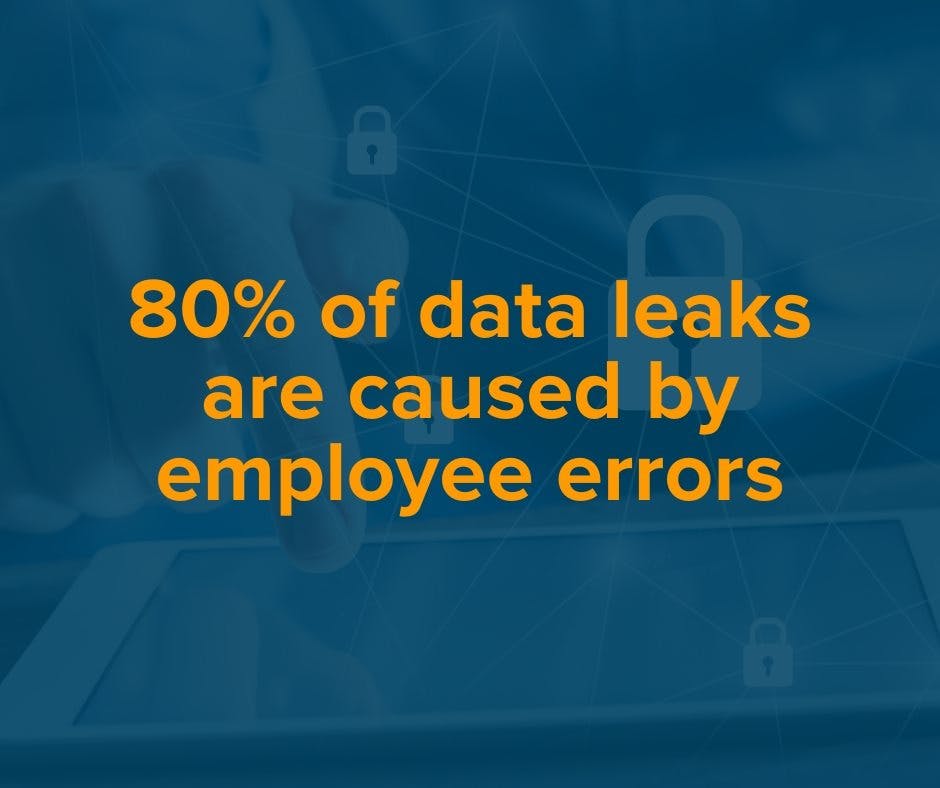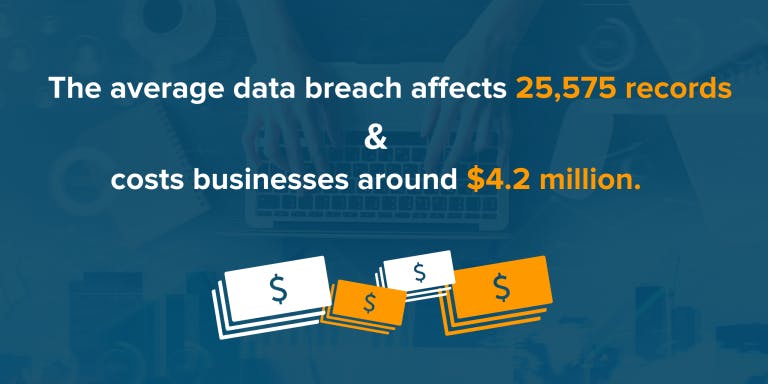A data breach can devastate a small business and be incredibly costly to enterprises. It’s important that your employees have a good understanding of the nature of the information your organization has and risks that are associated with mishandling it, unintentional or otherwise.
Take a look at some of the causes and disastrous effects of data breaches.
Cause: Lack of Employee Training
Employees can’t prevent something they don’t know about. That’s why it’s important to offer training to employees on the latest hacking and social engineering messages. Since 93% of malware comes from emails, your employees need to be filled in on things like phishing emails, typosquatting, and social media scams so they can be prepared.
Additional employee cybersecurity training could also be necessary for individuals. Perhaps Ellen in accounting often sends the wrong file link to clients or Sam in customer service has been known to share sensitive files with a personal email account. It may be time for them to take a training course.
If you can demonstrate to your employees that cybersecurity is a priority in your organization, then they will take it more seriously. Hold training to teach your staff about the latest cyber threats and preventive practices. Make sure your team members know what files they can and cannot share outside of your business and the most secure ways to share these files.
Cause: Shadow IT
Shadow IT can be a big problem for businesses of any size. If your employees are taking IT matters into their own hands and using devices, apps, and software for business without approval, they are leaving your organization vulnerable to data breaches.
Find out what tools your employees are using to get their work done. Are they using their email to send sensitive documents to their personal email address? Or using free WiFi in coffee shops?
There are so many great tools out there that can make work more efficient. Just because you don’t provide your team access to certain online tools, doesn’t mean they aren’t finding and using them. If each of your team members goes out on their own and finds a different tool, then you can’t be sure that files (and the important information they contain) are being handled with the appropriate level of controls. Just like a fragile box in the mail (or the emotions of others), your files need to be “handled with care.”
You can’t ask your team members to simply not use tools that make their lives easier. There are way too many benefits for them not to seek one out. So you’ll want to give them all access to specific, sanctioned online tools that will work in your favor.
Cause: Treating Sensitive Data Like Any Other Data
Whether it’s your client’s financial data or proprietary industry secrets, your business probably deals with sensitive information multiple times a day. Keeping your files secure is crucial since 27% of data breaches are caused by human error.
The safest thing to do would be never letting these files see the light of day again, but of course, that isn’t reasonable. You need a secure file sharing solution that works for your compliance and level of security.
With granular user management, you have control over who has access to what files and folders. Not everyone at your organization needs access to every file (and they probably don’t want it either). Simply put, some team members need access to certain files, and some don’t.
Your house designer might whip up a clean logo and some compelling graphics, but do they really need to have access to a client’s payment information? Here’s what else you need to think about with user management and file sharing.
Effect: Loss of Revenue
According to IBM Security and Ponemon Institute, the average total cost of a data breach is .19 million in the U.S., up from last year at .91 million.
The financial impact of a data breach can be astronomical. Not only is the compromised information worth money, but most likely, there will also be heavy fines and remediation costs. You also have to pay for your employees to investigate and fix the breach instead of doing their day-to-day jobs, or perhaps even more costly, hire an outside firm.
And let’s not forget about plain old lost business. People tend not to want to work with companies that have compromised their client’s information. The cost of lost business after a breach for U.S. organizations adds up to .2 million.
Effect: Loss of Trust
Keeping your files secure is crucial for protecting your clients and your company’s reputation. No organization wants to see their name in the headlines for a data breach. You can risk the permanent loss of consumer trust over security breaches.
The average size of a data breach 25,575 records, which means that each client associated with each of those records could decide that you can no longer protect their interests or information.
Even though notification costs after a breach for U.S. organizations add up to 40,000, not notifying your affected customers is simply not an option. Failure to disclose a cybersecurity breach could land you in hot water. Not only will consumers resent your organization for hiding it, but you may also find you are legally liable.
With a solution like SmartFile, we can keep your files safe and your data secure. You can significantly reduce your risks and get some peace of mind when you share files with SmartFile.


